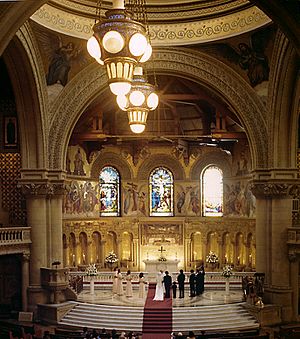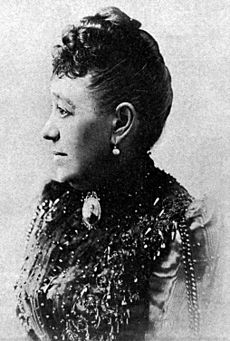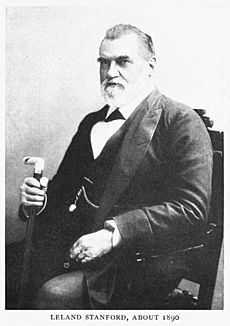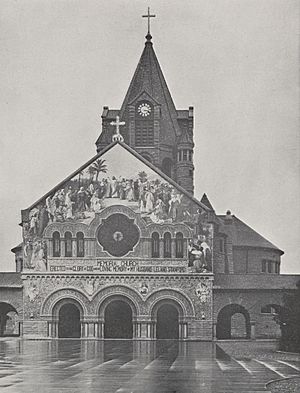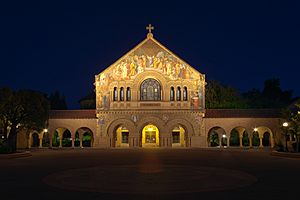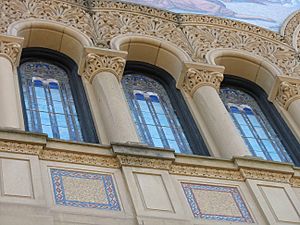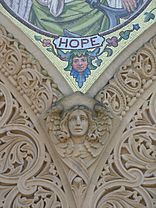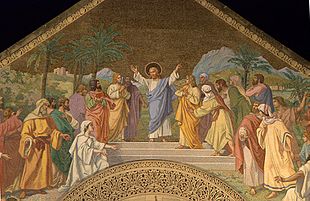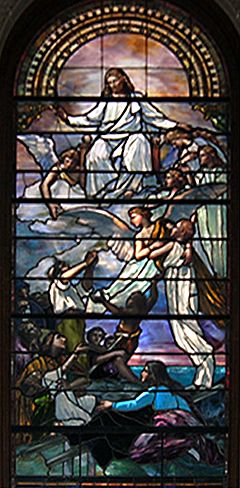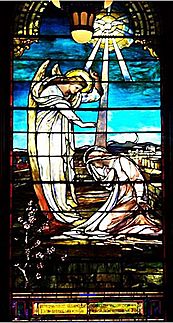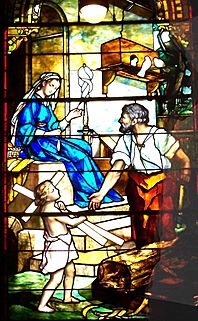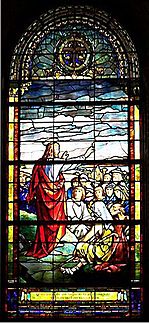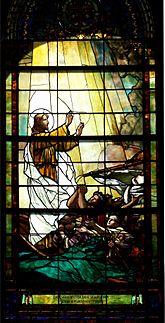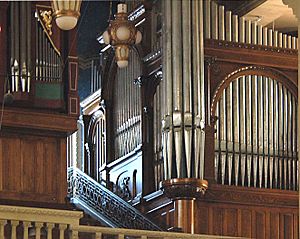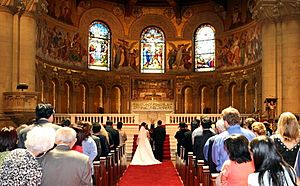Stanford Memorial Church facts for kids
Stanford Memorial Church, sometimes called MemChu, is a beautiful church at the heart of the Stanford University campus in Stanford, California. It was built by Jane Stanford as a memorial to her husband, Leland Stanford. The church is famous for its stunning architecture and amazing artwork.
The church was designed by architect Charles A. Coolidge and opened in 1903. Its style is a mix of Romanesque and Byzantine designs, inspired by churches in Venice and Ravenna, Italy. Inside, you can find colorful stained glass windows and detailed mosaics that show scenes from famous religious paintings. The church also has five pipe organs, which can play many different kinds of music.
Stanford Memorial Church is known for being a non-denominational church, which means it is open to people of all faiths. From the beginning, its purpose was to support the spiritual life of the university community. The church has survived two major earthquakes, in 1906 and 1989, and was carefully repaired after each one.
Contents
The Story of the Church
A Memorial of Love
Stanford Memorial Church stands in the center of Stanford University's Main Quad. It was built by Jane Stanford to honor her husband, Leland Stanford, after he died in 1893. The Stanfords were a religious couple and wanted the church to be the centerpiece of their university.
Jane Stanford wanted the church to be a place for everyone, so she decided it would be non-denominational. This means it wasn't tied to one specific branch of Christianity and could welcome people from all religious backgrounds. She believed this would help students grow not just in their studies, but also in their personal values.
Construction began in 1900. Jane was involved in every detail of the design. She hired an artist from Venice, Maurizio Camerino, to create the incredible mosaics that cover the church's walls. She wanted the church to be as beautiful as the historic cathedrals she had seen in Europe. The church was officially dedicated on January 25, 1903.
Jane Stanford once said, "While my whole heart is in the university, my soul is in that church." She passed away in 1905, just before a major earthquake damaged her beloved church. Her funeral was held there, honoring her as a visionary leader.
Surviving Earthquakes
Stanford Memorial Church has been badly damaged by two major earthquakes but was rebuilt each time.
The 1906 San Francisco Earthquake
The 1906 San Francisco earthquake caused massive damage. The church's tall central tower and spire collapsed, and the walls cracked. The beautiful mosaic on the front of the building was completely destroyed. The main reason for the damage was that parts of the building were not properly connected, so they shook apart during the quake.
The university decided to rebuild the church because it was such an important part of Stanford's identity. The repairs took years, from 1906 to 1913. Workers carefully took the building apart, stone by stone, and put it back together on a stronger steel frame. The tall spire was not rebuilt, but the clock was saved and later moved to a different tower on campus. The famous mosaic on the front was also recreated.
The 1989 Loma Prieta Earthquake
In 1989, the Loma Prieta earthquake struck. The damage was not as bad as in 1906, but it was still serious. The structure above the center of the church buckled, and large pieces of the mosaic angels high up on the walls fell 80 feet to the floor.
Once again, the church was closed for repairs. This time, engineers focused on making the building even stronger to protect it from future earthquakes. They added steel braces and concrete to support the walls and dome. The beautiful angel mosaics were carefully restored. The church reopened in 1992, stronger and more secure than ever.
Architecture and Art
Stanford Memorial Church is a stunning example of American Renaissance architecture. It mixes several styles, including Romanesque, Byzantine, and Victorian. Jane Stanford wanted the church to be filled with art and color, just like the great cathedrals of Europe.
The church is built in the shape of a cross (cruciform). The outside is made of buff-colored sandstone and has a red tile roof, matching the other buildings in the Main Quad.
The Dazzling Exterior
The front of the church, or facade, features a huge mosaic. It shows Jesus welcoming a group of 47 men, women, and children. This mosaic is 84 feet wide and was the largest in America when it was finished. It took 12 artists two years to create.
Below the mosaic are three arched doorways surrounded by detailed stone carvings of plants and angels. Jane Stanford wanted to include many images of women in the church's art to show the important role of women in religion.
The Glowing Interior
Inside, the church is a wonderland of glowing mosaics and colorful stained-glass windows. Jane Stanford disliked empty spaces, so nearly every surface is decorated.
The walls of the main hall, or nave, are covered with mosaics that tell stories from the Old Testament. High above the center of the church is a dome, supported by four huge arches. On the arches are mosaics of four giant angels, each stretching 42 feet from wingtip to wingtip.
The front of the church, called the chancel, is where the altar is located. Behind the white marble altar is a stunning mosaic copy of Leonardo da Vinci's famous painting, "The Last Supper."
The Stained-Glass Windows
The church has 20 large stained-glass windows that tell the story of the life of Christ. They were made by the famous J&R Lamb Studios in New York. The windows are incredibly detailed and use many layers of colored glass to create their beautiful effects.
One special window shows Christ welcoming a child into Heaven. This was a personal tribute from Jane Stanford to her son, Leland Stanford Jr., who died at age 15. The university was founded in his memory.
The Shimmering Mosaics
The mosaics are one of the most breathtaking features of the church. They were made in Venice, Italy, by the studio of Maurizio Camerino. The artists used over 20,000 shades of colored glass to create the shimmering, tapestry-like images.
The mosaics were shipped from Italy to California in small sections and then carefully put together on the church walls. The entire project took five years to complete. The mosaics cover the walls with scenes from the Bible, featuring prophets, apostles, and angels.
The Organs of Memorial Church
Stanford Memorial Church is home to five pipe organs, making it a major center for organ music.
- The Murray Harris Organ was the church's first organ, built in 1901. It has a rich, romantic sound.
- The Fisk-Nanney Organ was built in 1985 and is considered one of the finest organs in the world. It has almost 4,500 pipes and can play music from many different historical periods.
- The church also has three smaller organs, including a portable one on wheels and a rare Tudor-style organ.
A Church for Everyone
From its beginning, Jane Stanford wanted the church to be a welcoming place for all students, no matter their faith. This non-denominational approach was unusual for its time. The church's goal has always been to support the spiritual and moral growth of the university community.
Today, the church hosts a wide variety of services, including Christian, multi-faith, and private events. It is a popular place for weddings, with about 150 ceremonies held there each year for people connected to the university. It is also a quiet place for students and visitors to reflect and find peace.
See also
 In Spanish: Iglesia Memorial de Stanford para niños
In Spanish: Iglesia Memorial de Stanford para niños



